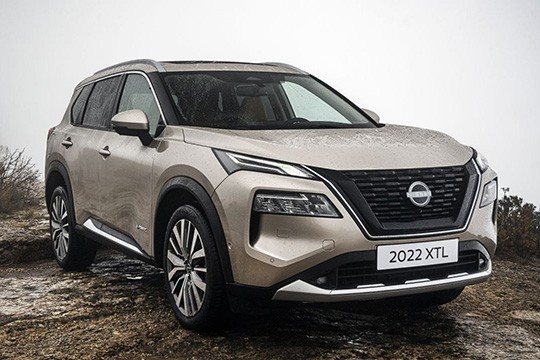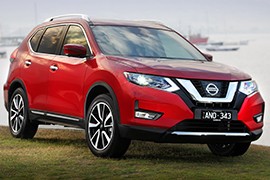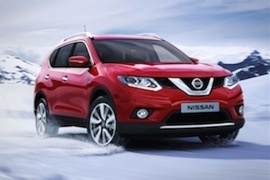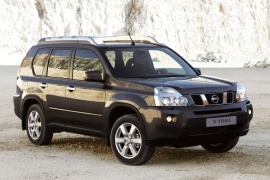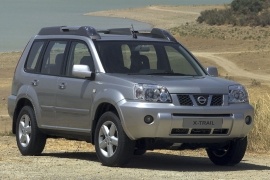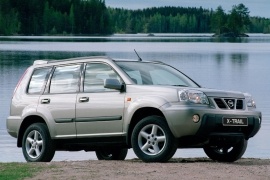NISSAN X-Trail Models/Series Timeline, Specifications & Photos
First production year: 2001
Engines: Hybrid gasoline, Mild hybrid, Gasoline, Diesel
Body style: SUV (Sports Utility Vehicle)
Nissan introduced the fourth generation of its crossover X-Trail at the 2021 Auto Shanghai in China, and it was more of a revolution in the car's history.
Based on the CMF-C platform shared with Nissan Qashqai and the 2022 Mitsubishi Outlander, the X-Trail, also known as the Rogue on the U.S. market, offered big changes on the exterior, interior, and drivetrain. Moreover, it had completely abandoned the turbo-diesel engines from its offer.
The front fascia of the 2022 X-Trail featured the same design-signature V-shape chromed trim included on the radiator's grille. On the sides, it was flanked by new LED headlamps, with an upper lamp for the parking lights and blinkers, while the lower ones served as headlights. The bumper sported a pair of side scoops that channeled the air on the car's sides, while on the lower area, it featured a broad grille. From its profile, the X-Trail was surprised with its D-pillar's shape and the raked-forward rear windscreen.
Inside, Nissan tried to create a premium atmosphere for its customers. Gone was the analog instrument panel, replaced by a TFT, while atop the center stack, it placed a 12.3" infotainment display. In addition, the carmaker offered the 2022 X-Trail with up to seven seats inside, with an option for two jump-seats in the trunk area.
Under the hood, Nissan offered just a choice of two drivetrains, both hybrid. The carmaker produced the fourth generation of the X-Trail, either with a front or an all-wheel drive system.
The third generation of the X-Trail was launched in 2013 and, by 2017, some of its features were considered outdated. But after its mid-life cycle refresh, it was just as good as its rivals, if not better.
With over half of century of experience in off-road vehicles and some of the best SUVs in the world, Nissan considered that it was about time to show its muscles. The new wave of Korean and German SUVs tried to steal its glory. So, the Japanese car-maker decided to step ahead with a new smile.
It wasn't exactly a smile, but an aggressive grin on the newly designed front fascia. If the non-facelifted version featured a simpler layout with somehow angled and clear-cut headlights, the facelift added a chromed element on the grille. It looked as if a knight just put on its steel helmet. From the side, the muscular lines and sculptured door panels amplified that warrior look.
Inside, the adaptive cruise control, the curved dashboard was kept but enhanced in the instrument cluster with a color display between the dials. Depending on the trim level, it was available with front and rear heated seats.
Under the hood, the 2017 X-Trail was offered with a choice of two gasoline and one diesel engine. It was mated to a 6 speed manual on the base model, while the top trim levels were fitted with the X-Tronic, automatic (CVT) gearbox.
After two generations of boxy design for its compact-size SUV, Nissan's designers found a way to make the X-Trail more aerodynamic and with softer lines.
The Renault-Nissan alliance worked together to build a new platform for their future models. The CMF (Common Module Family) platform served their interests and, in the autumn of 2014, the X-Trail was shown at the Frankfurt Motor Show, in Germany.
The vehicle's design took some elements from Nissan Murano and Qashqai (Rogue Sport), adopted the new grille with chrome around it and a raked windshield for less aerodynamic noise and lower drag resistance. The headlights featured LED and a nice DRL line on higher trim levels. A panoramic glass roof was offered as an option.
Inside, Nissan installed up to 7 seats, but the last row is very small, especially for the legroom. Fortunately, the middle row could slide forward to make more room. For the driver, the dashboard got its inspiration from X-Trail's smaller brother, the Qashqai, with big analog dials on the instrument cluster. The infotainment system was installed on the center console, at the same level with the steering-wheel making life easier for the driver.
The X-Trail was available with gasoline or diesel engines, with front-wheel-drive or all-wheel-drive. For the transmission, depending on the engine, it was available with manual, CVT or automatic gearbox. It had an intelligent all-wheel-drive system, that could break the wheel with the smallest amount of grip, in order to improve traction on the wheels that could hold on to the ground.
The Nissan X-Trail was a very important step for the Japanese car-maker. It was a light, compact, SUV, with a 4x4 system and no low-range gear. It was successful and followed in 2007 by its second generation.
The second generation of the Nissan X-Trail was introduced in 2007 at the Geneva Motor Show and sales started the same year. Even if it featured a similar design language as the first generation, it was a completely new vehicle. But it showed that the designers listened to its customers and the result was very good and it led to big sales all over the world.
The second-generation kept the rugged, boxy, design from the 2000 model, but with rounded corners and bigger headlights. A big and wide D-pillar was a characteristic detail for the second generation of the X-Trail.
Inside, there were important changes. The first generation featured an instrument cluster mounted on the upper side of the dashboard. The customers complained and the designers took notice and replaced them behind the steering wheel. The big interior was fit for five adults and the flat rear floor made more legroom for all three occupants in the back.
Since the Nissan was already in the Renault-Nissan alliance, the car was equipped with engines jointly developed by the two car-makers. The standard transmission was a 6-speed manual and, depending on the engine, a 6-speed automatic or a CVT was offered on the options list.
Nissan introduced a mid-life cycle refresh for the X-Trail's first generation in 2003, improving a car that was already one of the best in its segment.
The Japanese carmaker reacted slowly to the market shift from MPVs to SUVs. It started only in 2000, while Honda, Toyota, Subaru, and others competed against each other. But the X-Trail was a well-developed vehicle. Nissan didn't cut corners in making it, and that made it a serious contender.
The car's rugged appearance was not for nothing. Even though it didn't sport some fake plastic shields, the refreshed X-Trail showed some muscles under its squared bodywork. At the front, the grille resembled the one installed on the Patrol. Its steep windshield and vertical side windows confirmed its off-road heritage. Its high-mounted headlights and taillights protected them against bushes and small bumps. It wasn't the car-like SUV, such as the Subaru Forester or the Honda CR-V.
Inside, Nissan installed a wide and flat dashboard with the instrument cluster placed in the middle, like in the P12 Primera. Even though it was the best technical solution, the customers complained about that, and that's why Nissan changed it from the second generation. Its roomy interior was suitable for up to five adults and a large trunk.
Under the hood, Nissan upgraded the engine range, preparing it for the Euro 4 emission standards. Despite entering in a partnership with Renault, it didn't take any engines from the French carmaker.
Nissan used its experience in building 4x4 vehicles to create the 2001 X-Trail as a replacement for the Terrano and opened a new chapter in its history book.
While the body-on-frame vehicles started to fade away even from the 4x4 segment, Nissan had to find a solution to enter the SUV segment with a lighter vehicle but still capable enough to wear the Japanese brand's badge. So, in September 2000, it launched the X-Trail at the Paris Motor Show. The car was built on the same platform as the Primera, and the solution worked great.
With its chunky styling, the automaker created a vehicle that looked both rugged and still civilized. Its bulging wheel arches and the square-looking overall design fit both inside cities and into the woods. In addition, the comprehensive glass areas that surrounded the cabin were a promise for an excellent view from the inside, without dead angles. At the back, the vertical tailgate was flanked by high-mounted taillights, which were protected from small bumps in the parking lots and also from being scratched by bushes.
The interior carried over the idea of an instrument panel mounted in the middle of the dashboard, close to the windshield. Even though that solution was considered ideal by car designers, customers didn't like it. Yet, the big dials allowed drivers to see the speedometer without taking their eyes off the road. The front bucket seats were mounted high, and the rear split-folding bench was also designed for comfortable long travels. Last but not least, the trunk area was impressive for those times.
Unlike the Terrano/Pathfinder, the X-Trail featured a unibody construction with independent suspension in all corners. Under the hood, Nissan installed a choice of gasoline and turbo-diesel powerplants paired with either a five- or six-speed manual or four-speed automatic, depending on the version. The car was offered exclusively with an all-wheel drive setup.
